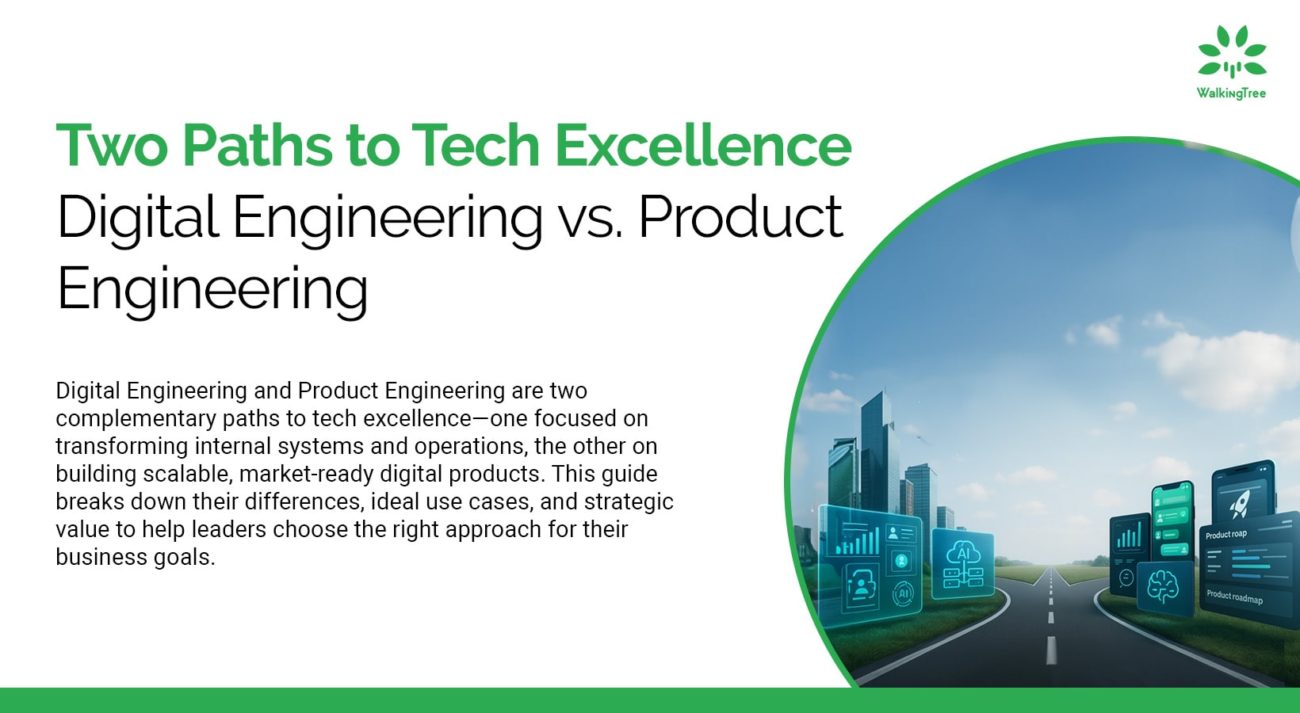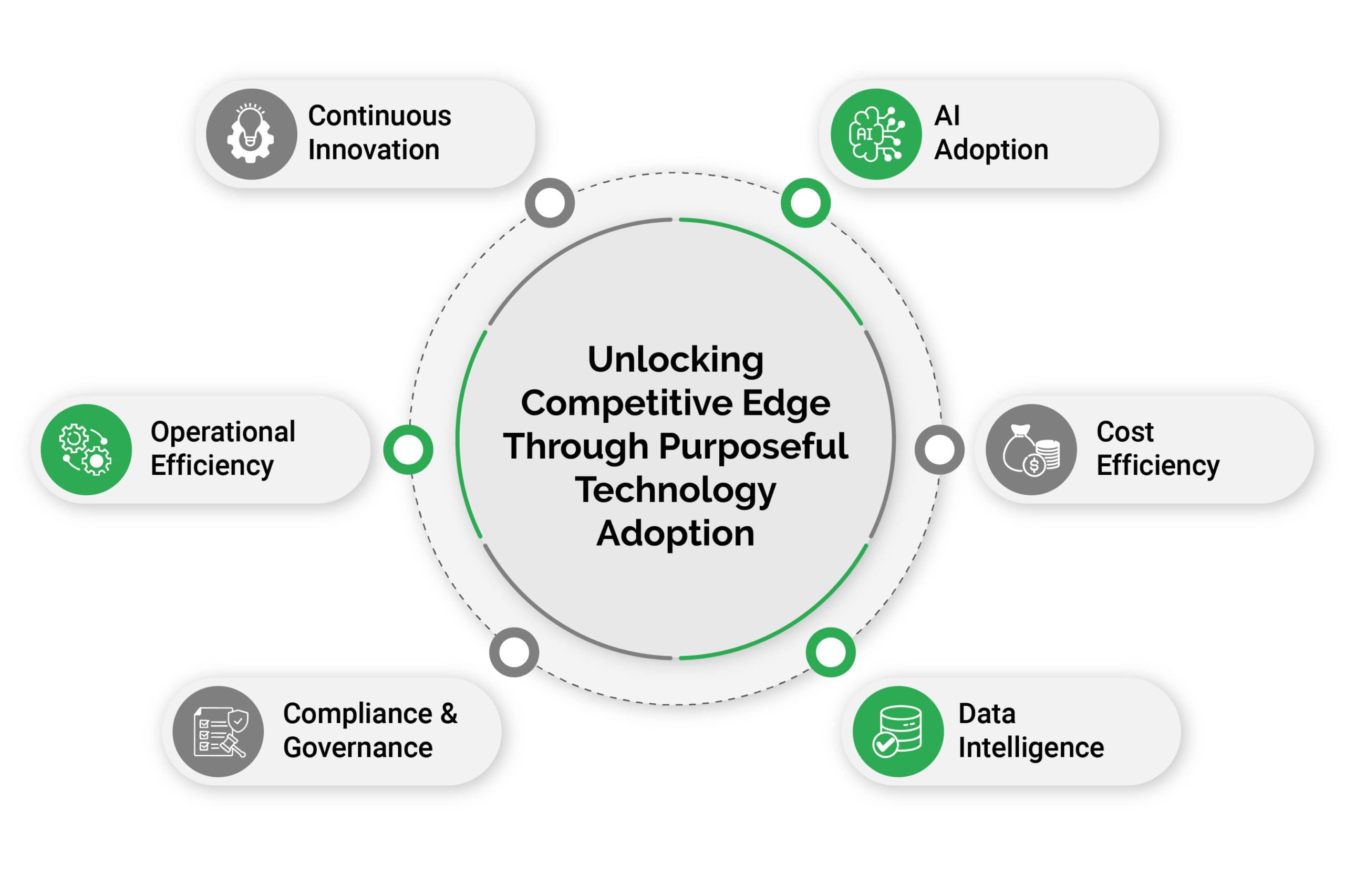Two Paths to Tech Excellence – Digital Engineering vs. Product Engineering


Business leaders are tasked with making high-impact decisions on how to modernize operations, launch digital products, and drive innovation. Two engineering approaches—Digital Engineering and Product Engineering—frequently emerge as strategic enablers. While they may overlap in execution, their core focus, outcomes, and stakeholder impact differ significantly.
This guide offers a comprehensive breakdown to help understand when and how to engage each model for maximum business value.
| What is Digital Engineering?
Digital Engineering refers to the application of emerging digital technologies—such as cloud, AI/ML, automation, data platforms, 3d Simulations, Blockchain and IoT—to modernize business processes, enhance customer experience, and improve organizational agility.
Why It Matters for Tech Leaders
Digital Engineering is a catalyst for digital transformation. It helps streamline operations, reduce technical debt, and enable better CX—all while preparing the business for future scale and innovation.
Key Characteristics:
- Objective: Drive enterprise-wide transformation
- Focus: Internal systems, operations, workflows
- Stakeholders: CIOs, Chief Digital Officers, IT Ops
- Deliverables: Legacy modernization, cloud migration, AI-based process optimization, Web/Mobile Applications, Unified Dashboards, etc.
- KPIs: Time-to-market, compliance, cost efficiency
For example, replatforming a retail bank’s legacy core system to a modern, AI-enabled cloud platform, reducing loan processing time from days to minutes.
Visit Our Digital Engineering Page
| What is Product Engineering?
Product Engineering is the discipline of designing, developing, and scaling market-ready software products—be it SaaS platforms, mobile applications, or digital marketplaces—with a user-centric and iterative approach.
Why does it matter for Product-Focused Organizations?
This model aligns technology with business innovation. It helps founders and CTOs bring new digital offerings to market quickly while maintaining scalability, usability, and long-term sustainability.
Key Characteristics:
- Objective: Deliver scalable, monetizable digital products for excellent customer experience.
- Focus: Customer-facing products, platforms, and tools
- Stakeholders: CTOs, Founders, Product Managers, Engineering VPs
- Deliverables: MVPs, SaaS Products, Software Platforms, microservices, APIs
- KPIs: Adoption, ARR/MRR, retention, engagement, scalability
For example, developing a multi-tenant SaaS platform for performance analytics in logistics, with built-in real-time dashboards and role-based access control.
Visit Our Product Engineering Page
| Digital Engineering vs. Product Engineering
Understanding the distinction between these two disciplines is critical for aligning investments, teams, and outcomes with your organization’s transformation goals. The comparison below outlines the key differences across key aspects that drive overall engineering success.
| Aspect | Digital Engineering | Product Engineering |
| Primary Objective | Drive digital transformation by modernizing legacy systems, enabling new digital experiences, and enhancing operational efficiency. | Deliver scalable, robust, and market-ready software products that solve customer problems or enable new business models. |
| Business Focus | Often tied to internal process improvement, customer experience transformation, or enterprise IT modernization. | Strong focus on external markets and users, building software as a product (SaaS, platforms, apps) with direct monetization goals. |
| Scope of Work | Includes legacy modernization, experience design, cloud enablement, AI integration, process automation, DevOps, etc. | Involves idea validation, architecture, engineering, usability, deployment, observability, product marketing, and continuous iteration. |
| Technology Stack | Heavy emphasis on cloud-native architecture, AI/ML, data engineering, IoT, cybersecurity, and platform integration. | Focus on full-stack development, microservices, CI/CD, performance engineering, product scalability, high-availability and globalization. |
| KPIs and Success Metrics | Operational efficiency, customer satisfaction (CX), time-to-market, compliance, process throughput. | Product adoption, user engagement, ARR/MRR, customer retention, scalability, and product quality. |
| Delivery Approach | Agile and incremental; integrates emerging technologies into existing systems to optimize or reinvent workflows. | Agile product lifecycle; iterative development with sprints, product-market feedback loops, and continuous enhancement. |
| Customer Impact | Enables faster, more intuitive, and personalized services. Improves internal agility and employee efficiency. | Creates products that directly solve customer needs, deliver business value, and generate revenue for the enterprises or startups. |
| Time Horizon | Mid-to-long term transformation initiatives aligned with strategic enterprise goals. | Short-to-mid term go-to-market goals with a long-term vision for growth and innovation. |
| Engineering Talent Required | Systems integrators, data scientists, AI/ML engineers, cloud architects, business analysts. | Product engineers, UX/UI designers, DevOps, backend/frontend developers, QA engineers, domain experts, compliance experts. |
| When Should You Choose Each Approach?
Selecting the right engineering approach is essential to achieving your business goals—whether you’re transforming enterprise operations or launching a market-facing product. Here’s how to determine which path aligns best with your current needs:
Choose Digital Engineering When You Need To
- Modernize Legacy Systems or IT Infrastructure: Upgrade outdated/legacy platforms and solutions to cloud-native, scalable architectures for improved performance and agility.
- Enhance Customer and Employee Experiences: Reimagine digital touchpoints and workflows to create intuitive, personalized, and efficient experiences by considering the latest technologies and expectations in perspective.
- Drive Enterprise-Wide Digital Transformation: Orchestrate cross-functional initiatives that unify business operations, data, and technology under a digital-first and AI-first strategy.
- Implement Strategic AI, Cloud, or Data Initiatives: Integrate emerging technologies—such as AI, ML, and advanced analytics—into core business processes.
Choose Product Engineering When You Are
- Launching a New Digital Product or Platform: Bring a product idea to life with end-to-end engineering—from concept to go-to-market readiness.
- Building or Scaling a SaaS Business: Develop scalable, secure, and high-performance platforms that serve users reliably at scale.
- Accelerating Time-to-Market with MVPs: Rapidly prototype, test, and iterate to validate product-market fit and reduce development risk.
- Focusing on User Engagement, Retention, or Monetization: Engineer experiences and features that drive long-term user value and sustainable revenue growth.
| Strategic Benefits for Technology Leaders

Partnering with WalkingTree empowers technology leaders to accelerate transformation, scale with confidence, and lead with innovation.
✔ Accelerated AI Adoption with Seamless Integration
Fast-track your AI, ML, GenAI, 3D Simulation and automation initiatives with expert-led strategies that integrate smoothly into your existing systems—ensuring minimal disruption and maximum alignment with business goals.
✔ Cost-Efficient Technology Leadership & Flexibility
Leverage the right engineering approach—Digital or Product—paired with flexible engagement models (e.g., fractional CAIO, dedicated teams, ODC or BOT) to optimize resources based on your growth stage and transformation roadmap.
✔ Predictive, Data-Driven Decision Intelligence
Enhance strategic and operational decision-making through real-time analytics, AI-powered insights, and intelligent automation tailored to your business priorities.
✔ Boosted Operational Efficiency & Scalable Revenue Impact
Reengineer processes, automate workflows, and elevate digital experiences—driving productivity, customer satisfaction, and measurable business outcomes.
✔ Built-In Compliance, Governance & Responsible AI
Navigate complex regulatory environments with confidence through WalkingTree’s focus on ethical AI, explainability, and adherence to standards like GDPR, HIPAA, and BFSI compliance.
✔ Continuous Innovation, Optimization & Growth
Stay ahead with agile delivery, continuous integration/deployment (CI/CD), and MLOps—ensuring your digital platforms and products evolve with market needs and performance feedback.
| Conclusion
While Digital Engineering is best suited for transforming existing business functions, Product Engineering is essential for innovating and capturing new digital opportunities. Together, they empower technology leaders to lead both from within and in the market.
At WalkingTree Technologies, we specialize in helping organizations leverage both paths. Whether you’re a CIO looking to modernize your digital estate or a Founder building the next big SaaS product, we bring the strategy, architecture, and engineering capabilities to help you succeed.
